Clashical Studies: How Alt-Right groups have clashed the narrative of ancient Mediterranean studies

Statue of Mithras. Marble, 100-200 CE. Rome, Italy. https://www.worldhistory.org/image/6222/statue-of-mithras/
Right wing Neoclassicist propaganda has been spewed for decades, leaving a sordid stain on the reputation of classical studies. White nationalists use twisted versions of Greek and Roman history to argue for white racial superiority. Some of this stems from 17th century whitewashed British curricula in classical studies, which then seeped into American higher education. The founders of our first universities in the New World modeled themselves on Oxford and Cambridge. The British believed that they were the inheritors of ancient Roman civilization and emphasized education in Latin to imitate it. Harvard (1636), the first college founded in America, took their teaching methods and focus on classical studies and Latin from the British. Harvard served a small percent of young white men who belonged to the elite, and the study of Latin and the classical world has continued to be dominated by white males. As Jonathan Karpinos, head of the Language Department, puts it,“There is a historical relationship that studying Latin has with joining elite groups in society.” The tendency for classics students to be white and male is one reason that racists have been able to co opt the study of ancient history to use as propaganda.
As white supremacy rises in America it has become imperative to shut down right wing myths that Ancient Greek and Roman civilization identified as white. This cultural appropriation of ancient Roman and Greek civilization, stemming from the implementation of British education into America’s first colleges, has evolved over time and can be seen nowadays as a symbol for Alt-Right groups. In the infamous 2017 “Unite the Right” Charlottesville rally, those on the right chanted “Jews will not replace us” and “Blood and Soil”. They also played dress up in Ancient Greek and Roman Military wear. Alt- Right groups such as Evropa aim to recruit young men to “preserve western culture” and use neoclassicist propaganda to appeal to their audience. Evropa was founded by Nathan Damingo, a man who said his movement was inspired by Klu Klux Klan Grand Wizard David Duke’s book My Awakening.
Many schools have, thankfully, detached themselves from the British model by promoting diverse representation in the classroom and rebuking false narratives about the race of Romans and how they depicted race. But schools still need more diversity in Classical classrooms to truly counter these issues. Unfortunately for some, prerequisites in higher education make that a challenge. Brittany Farrar, teacher for Upper School Classical Studies and Middle School Latin Teacher, said, “I could not remember a single student of color in my Latin or Greek classes, but people of color were in classical studies such as Roman and Greek.”
Additionally, access to high level Latin language classes remains as a more exclusionary aspect that bar wider demographics from entering, because many high schools in the US do not offer the language. Sophomore Elizabeth Fletcher, taking Ancient Greek, Latin, and Classical Studies, is from Des Moines, Iowa and shared a similar opinion as Farrar in regards to how accessible the language is. She said, “Latin was not even offered to me as a middle schooler. It’s not even offered at the high school I went to at home.”
Furthermore, Farrar recalled how privilege was tangible in her classical studies education in college. “There were definitely a lot of prep school kids, and I was not a prep school kid.”
Because there are not as many robust Latin programs nationwide compared to other languages and stereotypes of elitism in the language, an estimated 2 percent of students take Latin, but 17-18 states do not submit data on their language classes so this is a rough number. In England the disparities are more stark with Latin being taught in less than 3% of free state schools for students aged 11-16 compared to 49% of independent schools with tuition. As long as less economically and racially diverse students are denied Latin education, it will be harder for students to counter white supremacists’ argument that white males are the true inheritors of classical history.
Schools like Masters have contributed to opposing this narrative as it has made the language extremely accessible. Latin at Masters has been a requirement since its founding in 1877 and is required for all 6th grade students to take. Additionally Farrar made the switch for the middle school to learn off a new textbook called Suberanai instead of the Cambridge edition, because it premised on a female lead in a working class narrative and shows a more inclusive depiction of Roman cosmopolitan life. Although much work has been done to assuage this history of esotericism in the classroom, the pomp of classical education is still present in the United States and around the world discouraging students to take the language. Farrar said, “I think it’s so obvious that we need to do better.”

While managing her schoolwork, volleyball practices, and extracurriculars, senior Lydia Ettinger loves engaging in the world...



